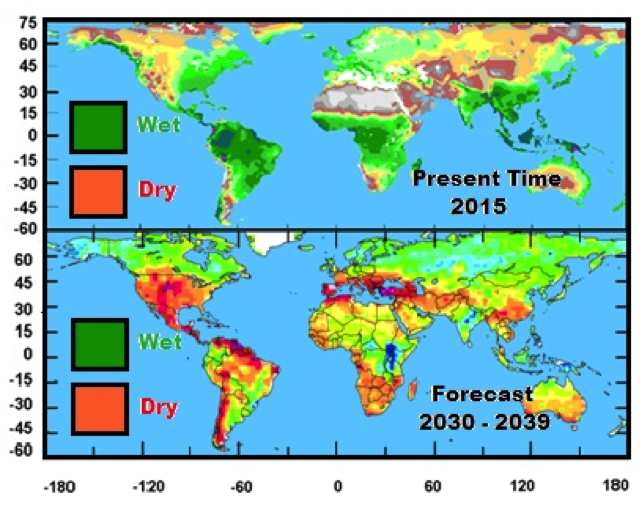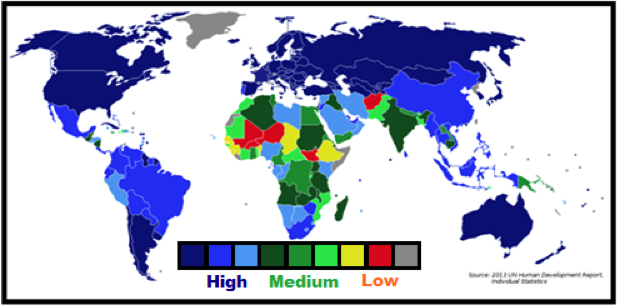
Figure 1. The future of the World population (Source: United Nations 2015a)
The most populated continent – also in the future − is Asia followed by Africa; of interest and to some extent of concern is the fact that Africa’s population will increase disproportionately (Table 1). Rather alarming is the fact that the population of the less developed regions of the world shows a stronger population increase than the more developed regions.
The figures in Table1 describe not only the population growth; they conceal a couple of facts which are highly relevant for the evolution of developing societies, with respect to Food Security and the ability of individual societies to manage their wellbeing, worth mentioning in particular are population stress with food insecurity and impoverishment.

Table1. Population of the world according to continents
and developed groups, medium growth scenario
Absolute figures/% of total population (from United Nations 2015b)

Figure2. World Hunger Map/Compliance with specified goals to reduce food security
(from FAO 2015)
The prevailing problem in Africa, South East Asia and parts of South America is the pronounced lack of food, this problem is especially relevant in Africa (see Figure 2). Even if the Millennium Development Goals are met, food security will be a serious problem in the developing world, especially in Africa where the compliance with the specified goals was and is rather poor (Figure 2).
A further factor which has to be encountered is the formation of huge population agglomerates with major negative impacts on the environment. It is expected that in the year 2025 up to one third of the world population will live in urban environments (Figure 3), and this trend will continue in the years beyond 2025.

Figure 3. World urbanisation in 2025 [from United Nations 2015b, modified]
The formation of agglomerations is strongly related to the availability of water, energy and food, three factors which are strongly interrelated. It is expected that especially the megacities in China are able to develop adequate infrastructures for their residents. Megacities and medium sized cities in India, Pakistan and the African continent are expected to suffer from slum development in various aspects especially with regard to dwellings, safe and secure food, and water supply (Figure 3).
On the social edge, with the formation of huge agglomerates an increase of general productivity has to be expected, a phenomenon which sees in general a growth of the middle class and unfortunately an increase of low income individuals – who will be exposed to food insecurity − especially in developing countries. From a food supply point of view the growing middle class leads to an increased demand of high density food items, especially meat. Compared to the production of grains and vegetables for direct consumption, increasing meat production requires a much larger share of the arable land and water resources.
To supply a growing world population in a changing geo-political, social and climatic environment, the agricultural production has to be increased and losses along the food chain have to be minimised.

Figure 4. Present time and predicted (2030 – 39)
global distribution of rainfall (World Climate Maps 2015)
An increase in agricultural production will only be possible by a better utilisation of the presently used arable land resources and an expansion of the arable land on account of virgin land and land so far not used for agricultural purposes. A further factor which has detrimental effects on the provision of food is climate, it is anticipated according to reputable sources that with raising environmental temperatures in future years more areas around the globe will experience droughts (Figure 4) with negative effects on food production, especially in the Americas, Southern Africa, the Middle East, and Australia.
A competing factor − especially with regard to remediating food insecurity − is the expansion of bio-fuel production in major food producing countries such as the USA and Brazil.
What are the Direct Consequences for Food Engineering?
The colorful picture of the future vulnerable global society indicates challenges which require amongst others responses by the food engineering community regarding the quantity and quality of the food supply-chain to the consumer.
Quantitative measures aim mainly at an increase and stabilisation of the product range through:
o better utilisation of conventional resources and opening of new unconventional resources;
o reduction of losses and wastage;
o development of new storage, packaging and transportation technologies (required to maintain freshness of fruits/vegetables and to some extent of processed products over longer periods of time, together with an reduction of the environmental stress by those processing elements);
o new types of distribution and retail outlets (digitalised shopping, door to door delivery, frequent deliveries in time because of minimal home storage facilities); and
o new types of food preparation.
Qualitative measures aim at a diversification of the product range reflecting cultural and religious traditions and responding to demands, e.g. by evolving lifestyles and new insight into nutritional-physiological processes by:
o food grown and processed in an ecological correct/safe way, and resource saving way;
o food grown in the region for direct market supply;
o food which is adequate for specific physical activities and health situations, e.g. DNA- based analysis;
o food which is demonstrating the social, ideological and religious orientation;
o food which is easy to prepare and eat.
To respond to these challenges the food engineering community has to develop a comprehensive and global strategy. This can only be done by an intensive discussion of individual approaches and concepts within the community and a dialogue with all partners involved in structuring the food chain. The request for a dialogue with all partners involved in the food chain is basically not a new one: it was however in most cases limited to agricultural, engineering, and nutritional sciences; meteorology, urban planning, architecture, and consumer science were excluded − to mention some examples − in addition ethical issues of concern to food production and processing should be considered.
Essential for the direct development of food engineering as a discipline is the understanding of changes − down to the molecular level − which food materials undergo during processing, storage and distribution and during home preparation. The understanding of interactions of the food components, especially during processing which determine the sensory and physiological properties of the final product, is the basis for the development of new processes and products.
Classical fields which need further development are:
o biotechnology, (eng-)omics, and the new biology:
· Integrated approaches have to be developed which combine (plant) meta-genomics with genomics of microorganisms and human genomics;
o processing techniques responding to nutritional requirements:
· thermal processing with a minimum damage to critical components;
· non-thermal processing applications should be expanded into new areas;
· mechanical processing/structuring should be applied to structure synthetic and natural proteins or carbohydrates into edible products;
· mechanical separation techniques should be applied to remove less valuable/ harmful components, enrich valuable components, fractionate components with different physical properties;
· nanotechnology and new accelerated reaction kinetics should be explored in close partnership with all involved in production processes (from processing down to consumption and physiological fate) especially with regard to the impact of nano-sized components in food on human health (risk analysis). Important will also be the evaluation of the stability of nano-materials in food matrices and during processing, storage, digestion. Of further interest is the bio-persistence of nano-particles in humans and animals;
o improvement of sensory properties/fortification of new and unconventional food products/processes and elucidation of those innovations will be required to unlock consumer resistance;
o hygiene:
· globalisation with an increasing international trade of food materials requires that food products be free of any pathogens and quality impairing substances especially in case of produces/products intended for international trade;
o postharvest processing:
· the presently enormous material losses after harvesting require the intensive use of classical postharvest techniques and the development of new techniques which can be applied;
o water;
· despite the fact that the amount of water used in food processing is almost negligible compared with the amount of water consumed for agricultural production, the use of water in processing is being considered as a key operation which is able to reduce the local environmental impact of food processing;
o waste reduction and utilisation of unconventional/underutilised resources:
· food waste and a large variety of produce which are underutilised or so far not used in the food chain can be valuable raw material resources. Their utilisation could relieve the pressure on the environment caused by the production of raw food materials. The general aim to produce high quality food with improved sustainability should include reduction and utilisation of waste through improved process efficiency resulting in saving of energy and water and reduction of waste and environmental pollution. Of interest are:
· reduction of losses along the food chain; finding safe uses for spoiled products in the food chain should receive high priority;
· reduction of mineral losses, e.g. through ion-exchange blanching;
· low temperature blanching;
· utilisation of peeling/boning waste;
· computer control for removal of damaged spots/trimming;
o food chemistry/ analytical issues/ enzyme technology:
· enzyme technology can play a pivotal role in unlocking new resources and a better utilisation of conventional resources
The Educational Domain Addressing Educational Tasks
For food professionals, a thorough knowledge of chemistry is necessary to understand factors affecting the quality of foods; the same is true for an orientation in engineering: in this case a broad natural science background and a profound education in relevant engineering subjects is required. Therefore these subjects should have a prominent place in the curricula of all university studies on food science and technology, after all the food economy should not be neglected. Basic knowledge of food chemistry is also a requirement for anyone dealing with nutrition in general or nutritional physiology and related fields. In order to grasp labeling information on packaged food items educated customers should at least understand terms such as proteins, carbohydrates, lipids, mineral components, vitamins, and additives. Very delicate areas are the media (TV, radio, journals, newspapers etc.) dealing with food and nutrition. It would be too much to require that journalists dealing with those subjects should have a profound food science related background, however it would help to allow for an objective coverage of food-related news especially in critical situations. All together there is a great need for strengthening and improving their educational exposure to food science and technology. The food industry in highly industrialised as well as in developing countries is permanently looking for qualified personnel, therefore increased emphasis should be put on attracting qualified students into food science and related areas.
The international food science community as such has a special obligation to disseminate food related information especially into areas were food insecurity prevails. Information on unconventional food resources and edible materials not necessarily on the daily diet sheet but also on inedible produces may help to mitigate to some extent the lack of an adequate food supply and may help to avoid intoxications. Important is that the provision of food related information has to be presented in a format understandable to the addressee, this is especially important in areas with high illiteracy rates (see Figure 5).

Figure 5. Global literacy rates (from UNDP 2015)
IUFoST Scientific Information Bulletin (SIB)
FOOD FRAUD PREVENTION